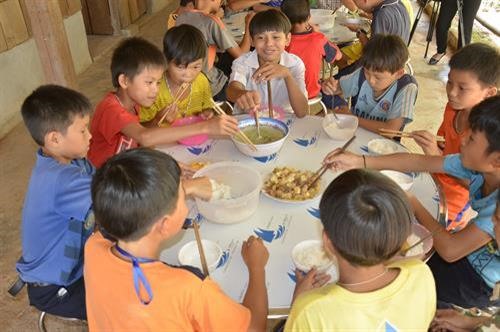 Society
Society

Malnutrition rates among mothers and children improved remarkably in the northern provinces of Lào Cai, Lai Châu and Hà Giang through a poverty reduction project, which ended in June 2018.
 |
| Malnutrition rates among mothers and children improved remarkably in the northern provinces of Lào Cai, Lai Châu and Hà Giang through a poverty reduction project, which ended in June 2018.— VNA/VNS Photo Hồng Điệp |
HÀ NỘI — Malnutrition rates among mothers and children improved remarkably in the northern provinces of Lào Cai, Lai Châu and Hà Giang through a poverty reduction project, which ended in June 2018.
The 32-month project, “Scaling up small-scale food processing for therapeutic and complementary foods for children in Việt Nam,” was implemented by the National Institute of Nutrition and the Ryerson University of Canada.
It promoted food security by increasing the availability of fortified complementary foods for children and providing a higher and more stable source of income for small-scale women farmers.
“The project has tackled poverty and malnutrition among women and children with fortified foods involving the use of locally grown crops, local manufacturing facilities and local distribution channels. The model is expected to improve livelihoods, nutrition and food security for thousands of rural Vietnamese farmers in the three provinces,” project official Huỳnh Nam Phương said.
“According to the results of the project, the child underweight rate was reduced to 13.9 per cent from 17.2 per cent, while the wasting rate (low weight for height) reduced from 7.6 per cent to 3.4 per cent. The rate of anaemia among children also reduced from 61.3 per cent to 16.1 per cent,” Phương added.
The project has benefitted more than 18,100 children underthe age of two through 10,150 counselling contacts and nearly 4,300 group counselling sessions. Some 450 women have been trained in Good Agricultural Practices, and some 15 easy-to-access Little Sun nutrition counselling centres have been set up at community health clinics at the provincial, district and commune levels.
An ISO22000 compliant SSFP food production facility has been established in Lào Cai province, with a capacity of 100 tonnes of fortified instant porridge and two million packets of vegetablesevery year. The facility currently serves food to nearly 2,500 students in four primary schools as well as to Lào Cai General Hospital.
According to Phương, the lesson learnt from the project will be the foundation for the development and implementation of national food security policies, such as Việt Nam’s National Nutrition Strategy. — VNS




